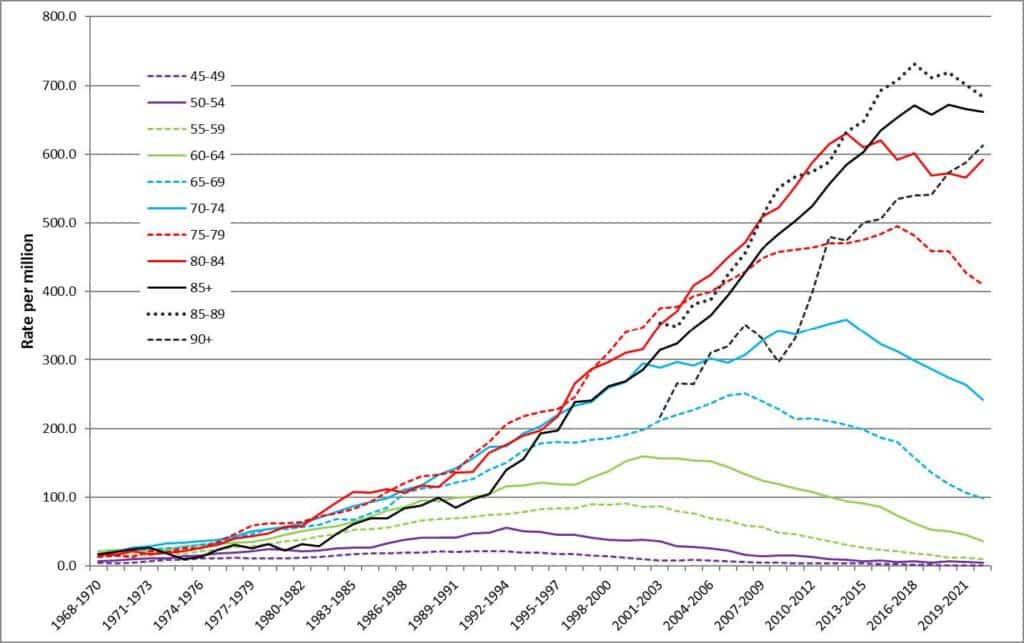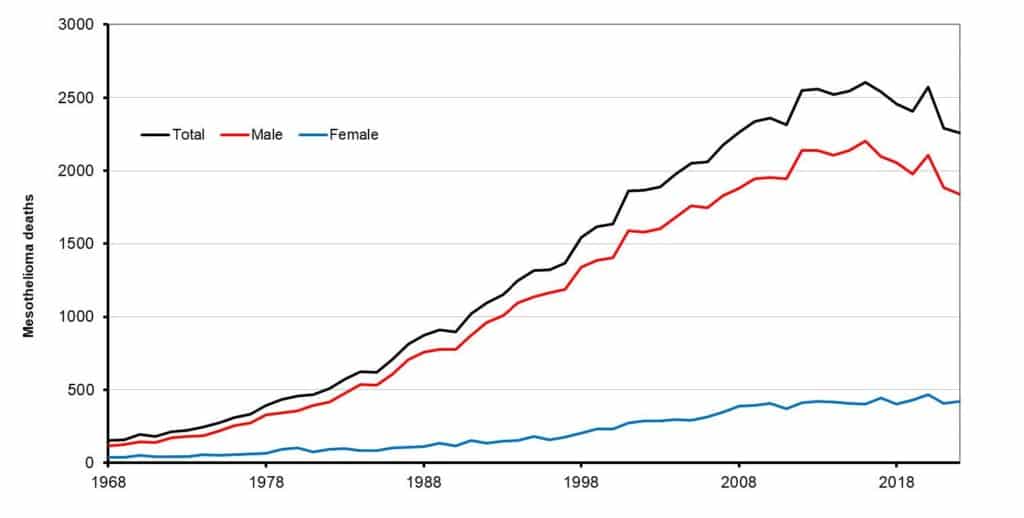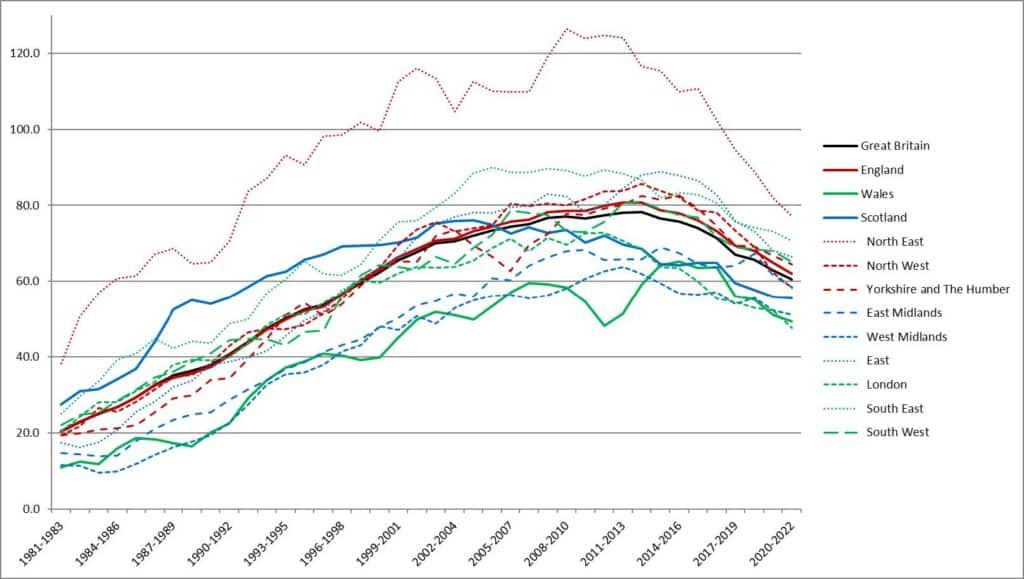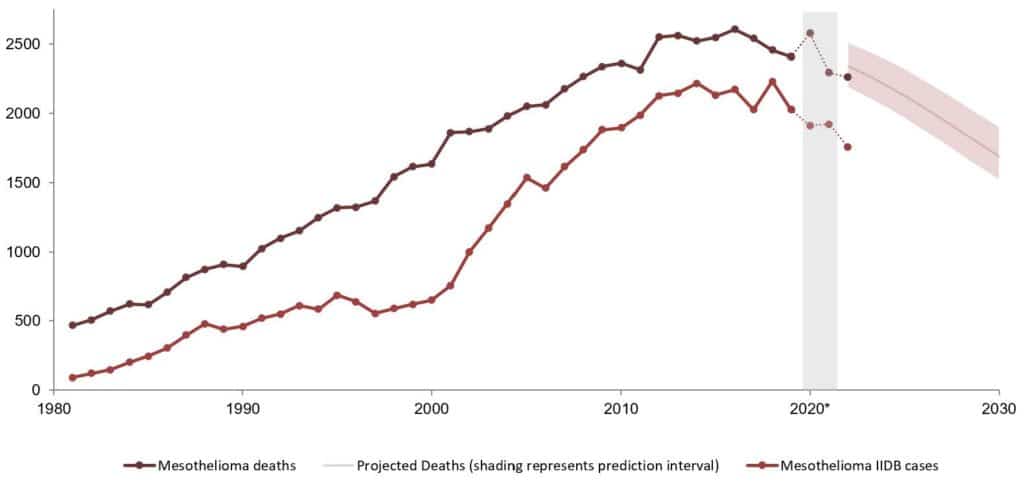What is the state of mesothelioma in the UK?
In July 2024, the Health and Safety Executive (HSE) – Britain’s national regulator for health and safety in the workplace – published its report Mesothelioma statistics for Great Britain, 2024, which set out a range of data in relation to the asbestos-linked cancer, mesothelioma.
Mesothelioma is a type of cancer that develops in the lining covering the outer surface of some of the body’s organs. The disease is strongly associated with past asbestos exposure for the affected individual. However, it has a long latency period, typically only manifesting some 30 years or more after the incident of exposure.
This condition is almost always fatal. Symptoms only tend to appear once the disease has reached an advanced stage of development, which means death often occurs within 12 months of the onset of symptoms.
The HSE’s latest report makes clear that exposure to asbestos continues to have a deadly impact in Great Britain. Even though it has been illegal to import and use any form of asbestos in the UK since 1999, and stringent regulations for asbestos management have been put in place since then, the disease still claims thousands of lives a year. This reflects the long-term consequences of past occupational exposures to the notorious fibrous mineral.
How does the 2024 HSE report reflect the current state of mesothelioma in the UK?
As the HSE report sets out, some 2,257 mesothelioma deaths were recorded for Great Britain in 2022. This is slightly below the 2,290 deaths the previous year, and substantially lower than the average number of deaths per year for the period from 2012 to 2020 – 2,529.
The effects of the long latency period for asbestos-related disease are clear in the longer-term statistics; the numbers of annual mesothelioma deaths in Great Britain hovered at around 2,500 over the course of 2012 to 2020. This was approximately 10 times the yearly number seen during the early 1970s, when the actual use of asbestos in industry was near its height.
Earlier projections were that yearly mesothelioma deaths would gradually decline on average during the 2020s, and the total number of deaths for 2022 is consistent with this.
There continue to be around 5,000 asbestos-related disease deaths a year in the UK, consisting of 2,257 mesothelioma deaths in 2022, and a similar number of lung cancer deaths associated with past asbestos exposure. It is anticipated that the overall numbers of asbestos deaths will continue declining on average for the remainder of the 2020s.
Why are mesothelioma deaths still so high despite regulations?
As referenced above, mesothelioma – in common with other forms of asbestos-related disease – is associated with a long latency period between asbestos exposure and the emergence of symptoms, of around 30 years or longer.
This latency period produces a “delayed” effect on the numbers of mesothelioma deaths, with many deaths in recent years being strongly linked to incidents of asbestos exposure that occurred when asbestos was still a legal-to-use material in the UK, including in the construction sector. Blue (crocidolite) and brown (amosite) asbestos were banned only as recently as 1985, and a complete ban on all types of asbestos wasn’t finally imposed until November 1999.
The 2024 HSE report provides information on male mesothelioma death rates by age and time period, from 1968 until 2022. The document points out that the pattern of death rates through the years reflects both disease latency and the timing of asbestos exposure.

Male mesothelioma death rates by age and time-period, 1968-2022
In the report’s words: “Current high death rates for males at ages 70 years and above… reflect the fact that this generation of men had the greatest potential for asbestos exposures in younger working life during the period of peak asbestos use in the 1950s, 1960s, and 1970s.”
What do the trends in male and female mesothelioma deaths reveal?
Figure 2, on page five of the 2024 HSE report, shows the trajectory of male and female mesothelioma deaths from 1968 to 2022. It reveals a substantially greater number of deaths among men than among women, reflecting the reality that heavy asbestos exposures historically tended to occur most often in male-dominated occupations (although of course, there was never a time when it was only men who were at risk of being exposed to asbestos).

Figure 2 – Page 5 of HSE Report
1,838 male deaths from mesothelioma were recorded for 2022, slightly down on the 1,883 male deaths seen in 2021. These figures, in turn, are both lower than the average of 2,107 male deaths per year from mesothelioma during the 2012 to 2020 period. It has been predicted that yearly numbers of male deaths from mesothelioma will gradually decline on average during the 2020s.
Female deaths from mesothelioma in 2022, meanwhile, were 419 in 2022, compared to 407 the previous year, and an average of 422 deaths per year over the course of 2012 to 2020. The HSE report stated: “Predictions for females suggest that there will continue to be 400-500 deaths per year during the 2020s.”
This raises an interesting question: why has there been a pattern (and now projection) of declining male deaths, but stable female deaths? The HSE document suggests this may be a result of especially heavy asbestos exposures in certain industries that principally affected men – such as shipbuilding – being eliminated first.
By contrast, exposures arising from the use of asbestos in the construction sector – another industry largely associated with male workers over the decades, but with some women also impacted – continued after 1970.
How does region and occupational background influence mesothelioma risk in the UK?
Pages eight and nine of the 2024 HSE report provide information about mesothelioma mortality by region and occupational background, and come with important insights.

Mesothelioma Cases by Region
The document points out, for example, that according to an epidemiological study of mesothelioma in Great Britain, there is an especially high burden of disease among former building workers. That particular research suggested that around 46% of the mesothelioma cases among men born in the 1940s would be attributed to such exposures, with 17% being attributed to carpentry work alone.
It is crucial to note, however, that the mesothelioma risk extends beyond traditional blue-collar jobs. Certain white-collar professions such as teaching have also been linked to mesothelioma risk, due to the presence of asbestos in schools and public buildings.
Regionally, the highest mesothelioma mortality rates are found in areas with a strong industrial history, although death rates have stabilised or slightly decreased in recent years across most regions. Male rates continue to be higher overall, particularly in regions like England and Wales, where industrial asbestos use was prevalent.
What is the role of the Industrial Injuries Disablement Benefit (IIDB) in supporting mesothelioma victims?
The Industrial Injuries Disablement Benefit (IIDB) scheme provides no-fault state compensation to employed earners for occupational diseases. As the 2024 HSE report mentions, mesothelioma is a prescribed disease within this scheme.
In 2022, 1,755 new cases of mesothelioma were assessed for IIDB, which is down from the previous year’s 1,920. It is important to point out that yearly IIDB cases are lower than annual deaths, due to such factors as not everyone with mesothelioma being eligible, and potentially some people failing to claim due to not being aware of the scheme.

Annual mesothelioma deaths, IIDB cases and projected future deaths to 2030 in UK
What is the broader impact of asbestos-related diseases in the UK?
As we touched upon earlier in this article, while the HSE report focuses on mesothelioma, it is crucial to recognise that the inhalation or ingestion of asbestos can also heighten the risk of the exposed individual developing a range of other potentially fatal health conditions. These include the likes of asbestos-related lung cancer, asbestosis, and pleural thickening.
Estimates have suggested that for every mesothelioma death, there could be two additional deaths from asbestos-related lung cancer. This implies that the total number of asbestos-related deaths in Great Britain each year could be approximately 5,000. It is an illustration that the overall impact of asbestos exposure is broader and more severe than the HSE’s mesothelioma report alone indicates.
What impact has COVID-19 had on mesothelioma statistics?
The COVID-19 pandemic brought further complexities to the statistics on mesothelioma mortality. It is believed, for example, that some patients with mesothelioma may have died earlier than might have otherwise been the case, due to contracting COVID-19. Pandemic-related delays in death registrations may have also slightly affected the reported figures.
However, such factors haven’t obscured the broader overall trend, which is that mesothelioma continues to be a significant cause of death, especially among older individuals whose asbestos exposure occurred decades earlier.
What are the future projections for mesothelioma in the UK, according to the 2024 HSE report?
The 2024 HSE report also sets out the predicted future course of mesothelioma deaths over the coming years. Overall, it is anticipated that male mesothelioma deaths will gradually decline, but that the numbers of female deaths are likely to remain at their current levels throughout the 2020s, before eventually decreasing.
As we referenced above, this pattern reflects the different occupational exposures over time among men and women, with especially heavy asbestos exposures in male-dominated sectors – such as shipbuilding – having been brought to an end earlier. It took longer for asbestos use to be reduced in industries where women were employed.
Conclusion: what can be done to address the ongoing mesothelioma crisis in the UK?
Although the 2024 HSE report on mesothelioma deaths focuses on one disease that happens to be strongly associated with asbestos exposure, it nonetheless paints a stark picture of the enduring legacy of the fibrous silicate mineral’s use in Great Britain.
Despite a final ban on all types of asbestos having been imposed more than a generation ago – in 1999 – it is clear that with thousands of deaths still occurring annually, and the substance still present in great numbers of buildings across the UK, asbestos remains a significant public health threat.
The sobering data on mesothelioma deaths underscores the importance of renewed efforts to address asbestos risks in the UK, particularly in ageing buildings where exposure may still occur.
Property managers, contractors, and employers all have their parts to play, including when it comes to complying with existing asbestos regulations. The UK Government, too, could contribute greatly to ending the mesothelioma crisis sooner, if it decides to strengthen asbestos safety measures and policies.
Encouraging the highest possible levels of asbestos awareness, which can help ensure asbestos-containing materials (ACMs) are identified and then proactively and safely managed, is imperative. Such courses of action will help prevent future cases of mesothelioma, thereby minimising the tragic consequences for public health and people’s lives.
To learn more about our own accredited and licensed asbestos services here at Oracle Solutions, and to receive a free and fast quote, please don’t hesitate to contact our team.

Written by Jess Scott
Jess Scott has been an all-round asbestos consultant since 1996. That’s nearly 3 decades of asbestos knowledge. He spends his time sharing that knowledge with the team at Oracle and with their clients. Jess's goal is, and always has been, to use my expertise in helping people to comply with the law. This legal compliance ultimately helps to protect everyone from the harmful effects of asbestos. Jess has acted as an asbestos expert witness in legal cases and is involved in many asbestos educational activities throughout the UK.
